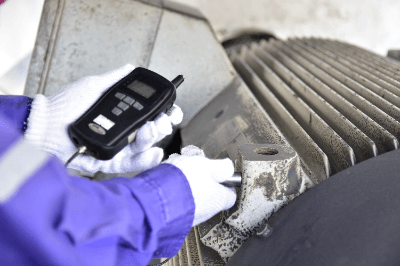What Is a Vibrometer?

A vibrometer is a device that measures the magnitude of an object’s vibration. Vibration magnitude is generally expressed on three scales: displacement, velocity, and acceleration.
It is essential to select which parameter to measure depending on the type of vibration you wish to measure and the item you want to evaluate. When measuring acceleration, it is sometimes referred to as an accelerometer.
Uses of Vibrometers
Vibrometers are widely used in research and development, production, and environmental protection. In the field of research and development, for example, the vibration characteristics of parts are measured during the product development stage to prevent resonance, damage, and abnormal noise.
In the production field, for example, vibration measurement of engines is used as a method of product shipment inspection to determine whether the engine is acceptable or not. In addition, to prevent damage caused by transportation, vibration during the transport is reproduced by testing equipment to improve packaging.
For turbine generators, for example, we monitor vibration during operation to detect malfunctions at an early stage. In the field of the environment, vibration measurement is essential for solving pollution problems caused by vibrations from factories and construction work.
The effect of vibration on the human body is determined by measuring the vibration level, which represents the ratio of vibration to a reference acceleration. Vibration levels are defined in ISO and JIS and are used to determine the riding comfort of automobiles and railroad cars.
They are also used to measure earthquake vibration and issue warnings and earthquake vibration waveforms to evaluate buildings’ earthquake-resistant and vibration-isolated structures.
Principle of Vibrometers
Vibration detection in vibrometers uses what is called a pickup. Pickups include piezoelectric, electromagnetic, mechanical, optical, and electromagnetic types.
1. Piezoelectric Vibrometers
The force generated by vibration is converted into a voltage proportional to that force by the piezoelectric effect of the piezoelectric element. There are two piezoelectric vibrometers: the shear type, which measures the strain on the surface of the piezoelectric element, and the compression type, which has a simple structure with a weight on the piezoelectric element. They are compact and lightweight and can measure up to a high-frequency range.
2. Electromagnetic Vibrometers
This type consists of a magnet and a coil and measures changes in the electrical current generated by electromagnetic induction depending on the positional relationship between the interest and the coil caused by vibration.
3. Mechanical Vibrometers
Using a MEMS (micro-electric mechanical system) semiconductor element, this vibrometer measures changes in electrostatic capacitance in response to the displacement of a variable electrode.
4. Other Vibrometers
Optical vibrometers measure displacement by irradiating a laser beam, and electromagnetic vibrometers measure relative displacement using a microwave Doppler laser. These methods do not require a pickup to be attached to the vibrating object and are suitable for measuring the vibration of small things, hot objects, and liquid surfaces.
Other Information on Vibrometers
1. How to use the Vibrometers
It is recommended that the pickup be firmly fixed with stud bolts or other means so that it is in close contact with the non-measuring object. If the mounting method is not firmly fixed, the pickup may become a filter, and accurate measurement will not be possible.
Fixing methods other than stud bolts include the use of adhesives and magnets. Frequency analysis is widely used to analyze vibration. It is a method to determine what frequencies and how much intensity each frequency contains in the measured waveform.
2. Unit of Vibration
The definition of mechanical vibration is defined by JIS as a temporal change in the magnitude of a quantity representing the motion or displacement of a mechanical system, alternating between a state greater than and less than a certain average or reference value. Vibration consists of three elements: amplitude, frequency, and phase. When measuring vibration, there are three parameters: displacement, velocity, and acceleration, and vibrometerⅹs are used to measure these parameters.
The practical units of vibration are
- Displacement: cm, μm (=10-6 m), nm (=10-9 m)
- Velocity: cm/s, mm/s
- Acceleration: cm/s2, Gal (Gal = cm/s2), G (Gee = 9.80665 m/s2)
For vibration level meters used to measure environmental vibration, the magnitude of environmental vibration is evaluated by the vibration level (dB), which is a measurement value based on the vibration sensory characteristics of the human body. This is the same concept as the noise level, and the measured value obtained after correcting the physical vibration amount by the sensory characteristics of the human body is used as the evaluation target.
- Vibration level L = 20log(V/ V0) [dB]
- V0: Reference vibration acceleration
- V: RMS value of vibration acceleration (r.m.s.)
V0 is used as 10-5 m/s2 in Japan and 10-6 m/s2 overseas.